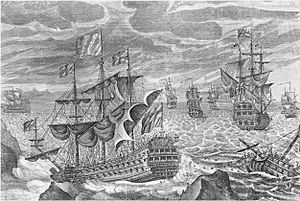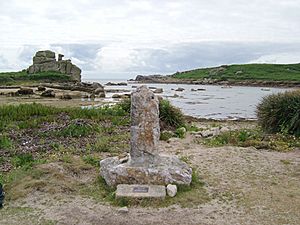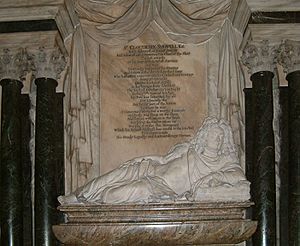Cloudesley Shovell facts for kids
Quick facts for kids
Sir Cloudesley Shovell
|
|
|---|---|
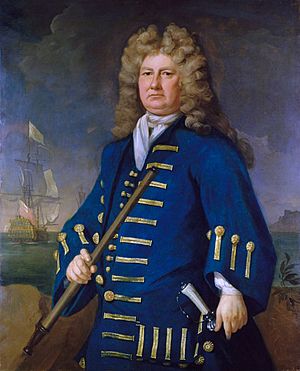
Sir Cloudesley Shovell by Michael Dahl
|
|
| Born | November 1650 Cockthorpe, Norfolk |
| Died | 22 October or 23 October 1707 Off the coast of Scilly |
| Buried |
St Mary's, Isles of Scilly, later moved to Westminster Abbey
|
| Allegiance | |
| Service/ |
|
| Years of service | 1664–1707 |
| Rank | Admiral of the Fleet |
| Commands held | HMS Sapphire HMS Phoenix HMS Nonsuch HMS James Galley HMS Anne HMS Dover HMS Edgar HMS Monck Irish Squadron Lisbon Station Mediterranean Fleet |
| Battles/wars | |
| Other work | MP for the city of Rochester |
Sir Cloudesley Shovell (born around November 1650 – died 22 or 23 October 1707) was a very important English naval officer. He became an Admiral of the Fleet, which was the highest rank in the Royal Navy.
As a young officer, he fought in battles during the Third Anglo-Dutch War. Later, as a captain, he took part in the Battle of Bantry Bay. He became a senior officer and led a group of ships at the Battles of Barfleur and La Hogue. In this battle, he was the first to break through the enemy's battle line.
During the War of the Spanish Succession, Shovell commanded a fleet that helped capture Gibraltar and attack Toulon. Sadly, he died in a terrible shipwreck off the Isles of Scilly on his way back to England. More than 1,400 sailors were lost that night. Besides his naval career, Sir Cloudesley Shovell also served as a Member of Parliament for Rochester.
Contents
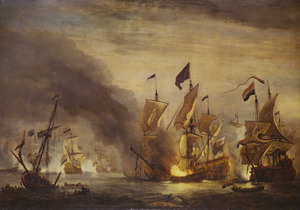
Cloudesley Shovell was born in Cockthorpe, Norfolk in November 1650. His family was respected but not very rich. His unusual first name, Cloudesley, came from his grandmother's family name.
He started his life at sea very young, around 1663, as a cabin boy. He was under the care of Admiral Christopher Myngs. After Myngs died, he continued his training with Admiral John Narborough. Cloudesley was a quick learner and very brave. He studied navigation and quickly moved up the ranks.
In 1672, he became a midshipman on the ship HMS Royal Prince. He fought in the Battle of Solebay in May 1672. This battle was part of the Third Anglo-Dutch War, where British and French ships fought against the Dutch.
Rising Through the Ranks
Shovell continued to gain experience. In 1673, he fought in another major battle, the Battle of Texel. Later that year, he became a lieutenant. In 1675, he joined HMS Harwich and took part in a fight against pirates in Tripoli, Libya.
He led a surprise attack on the pirates in January 1676, sinking several of their ships. For his bravery, he received money and a gold medal from King Charles II. The King was very pleased with his actions.
In 1677, he became a captain and commanded several ships, including HMS Sapphire and HMS Phoenix. During this time, he helped defend Tangier from raiders.
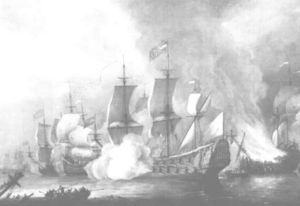
In 1689, Shovell commanded HMS Edgar. He fought in the Battle of Bantry Bay in May 1689. In this battle, a French fleet tried to land troops in Ireland. After the battle, Cloudesley Shovell was knighted for his bravery. He then helped convoy King William across the sea to Ireland.
Important Commands and Battles
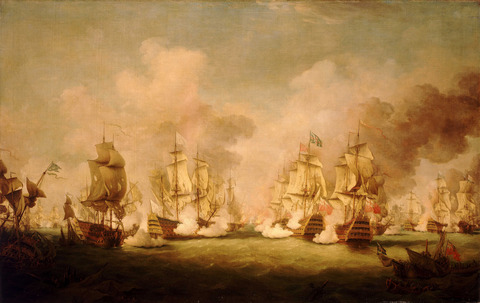
In June 1690, Shovell was promoted to rear-admiral. He commanded the Irish Squadron, providing naval support.
Breaking the Enemy Line
He played a key role in the Battles of Barfleur and La Hogue in May 1692. Here, the Anglo-Dutch fleet stopped the French fleet. Shovell's ship was the first to break through the enemy's line of ships. He was injured during the battle but still helped organize an attack that destroyed French ships.
After this success, Shovell was put in joint command of the fleet with two other admirals. However, after a difficult attack on a convoy in 1693, all three admirals were removed from their joint command. In 1694, Shovell was promoted to vice admiral and led squadrons on expeditions to French towns.
Life on Land

In 1694, Shovell settled in Crayford with his wife. He was elected as a Member of Parliament for Rochester in 1695. He helped restore a church in Crayford and was very generous to Rochester. He paid for beautiful ceilings in the Guildhall and a clock for the market. He also helped maintain the riverbanks of the River Thames. He did not run for re-election in 1701.
War of the Spanish Succession
In May 1702, Shovell became a full admiral. He brought home treasures captured from French and Spanish fleets. These were taken by Admiral George Rooke at the Battle of Vigo Bay.
Capturing Gibraltar and Barcelona
In 1704, Shovell commanded a squadron that helped capture Gibraltar. He also helped fight off the French fleet at the Battle of Málaga. In 1705, he was promoted to Admiral of the Fleet.
He was re-elected as a Member of Parliament for Rochester in 1705. That same year, he commanded the Mediterranean Fleet. His forces worked with the Earl of Peterborough to capture Barcelona in September 1705. In 1706, he was given complete control of the Mediterranean Fleet.
Attack on Toulon
In the summer of 1707, Shovell led the naval part of a big attack on Toulon, France. This was the main base for the French fleet. His forces worked with the Austrian army. Although they didn't capture the city, Shovell's bombardment caused the French to sink their own ships to prevent them from being captured. After this, Shovell was ordered to bring his fleet back to England.
On the way back to England, Shovell's flagship, HMS Association, hit rocks near the Isles of Scilly. This happened at 8 PM on October 22, 1707. The ship sank in just a few minutes, and all 800 men on board were lost. Three other large ships also sank that night: HMS Eagle, HMS Romney, and HMS Firebrand.
Nearly 2,000 sailors died in the Scilly naval disaster. It was one of the worst maritime disasters in British history. One reason for the disaster was that sailors at the time found it very hard to figure out their exact position at sea, especially their longitude.
The Discovery of Shovell's Body
Shovell's body, along with those of his two stepsons, was found on the beach at Porthellick Cove. This was about 7 miles from where his ship sank. It's thought that he might have left his ship in a small boat, but drowned trying to reach shore.
His body was identified by a mole under his left ear and an old injury to his finger. He was first buried on the beach. But by order of Queen Anne, his body was later moved to Plymouth and then taken to London. Large crowds came to pay their respects along the way. Sir Cloudesley Shovell was buried in Westminster Abbey on December 22, 1707. His monument there was created by Grinling Gibbons. His stepsons were buried on St Mary's.
Legends and Legacy
There are local legends about Shovell's death. One story says he was alive when he reached shore but was murdered by a woman for his valuable emerald ring. This story claims the woman confessed years later. However, many historians doubt this story because there's no proof the ring was found, and it sounds like a dramatic tale.
Another legend says a sailor tried to warn Shovell that the fleet was off course, but Shovell had him hanged for mutiny. This story appeared much later and has been disproven by naval experts. Despite these legends, Sir Cloudesley Shovell became a popular British hero after his death.
Family Life
In 1691, Sir Cloudesley Shovell married Elizabeth Hill. She was the widow of his former commander, Sir John Narborough. Through her, he had two stepsons, John and James Narborough. Both of them became naval officers and sadly died with Shovell in the 1707 shipwreck.
Shovell and his wife also had two daughters. Elizabeth married Lord Romney, and Anne married John Blackwood.
In Popular Culture
Actor Jonathan Coy played Sir Cloudesley Shovell in the TV series Longitude in 2000.
Images for kids


